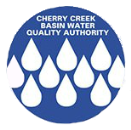2019 Annual Report on Activities
Cherry Creek Basin Water Quality Authority
Key Takeaways 2019
The Cherry Creek Basin Water Quality Authority (CCBWQA) is tasked with improving, protecting and preserving water quality for beneficial uses. We are pleased with and proud of our work.
Monitoring and Compliance
In Water Year 2019 (WY 2019) the July through September average chlorophyll a concentration in Cherry Creek Reservoir (CCR) was 16.03 ug/L, which is below the 18 ug/L seasonal standards. CCR met the aquatic life standards for temperature, dissolved oxygen and pH in 2019.
WY 2019 included a wet spring and a dry late summer and early fall. Precipitation patterns are a factor in CCR’s water quality.
When looking at the last 28 years, flows at the USGS gage near Franktown (located near the center of the watershed) were 17% less than average and flows at the USGS gage near Parker (located in the lower 1/3 of the watershed) were 14% above average. Urbanization patterns are a factor in CCR’s water quality and flows.
CCBWQA
CCBWQA is directed by an 18-member Board of Directors, who are backed by a Technical Advisory Committee. CCBWQA was created by Colorado Revised Statutes 25-8.5-101 et seq. and is required to spend 60% of its revenues on Pollutant Abatement Projects.
Planning
CCBWQA did a lot of planning, resulting in a Strategic Plan, details of which can be found below. CCBWQA’s 2020 Budget has, for the first time, funds for partnering with Member Entities and the Mile High Flood District on Master Planning for Cherry Creek and some of its tributaries. In addition, study and planning are occurring surrounding the domestic water issues and their impact on water quality in the Cherry Creek Basin. It is CCBWQA's intent to further its partnerships with Member Entities to explore this emerging issue, and to work closely with WQCD as the distinctions between water and wastewater treatment evolve. CCBWQA is perfectly situated to be a leader and a laboratory.
Pollutant Reduction Facilities (PRFs)
In 2019, CCBWQA contributed over $585,000 on stream reclamation projects and almost $93,000 on other pollutant reduction facilities. While CCBWQA did not meet the 60% spending requirement for pollutant abatement projects in 2019, the 2020 budget anticipates spending $3,661,000, significantly more than the 60% spending requirement. One PRF, the Cottonwood Creek “treatment train” achieved 69% reductions in phosphorus, 12% reductions in nitrogen, and 90% reductions in total suspended solids during storm events in 2019. $8.4 million of Pollution Abatement Project development, operations and maintenance budget is included in CCBWQA 10 year Capital Improvement Plan.
Point Source Controls
In WY 2019, all 6 wastewater plants in the basin were in compliance with their nutrient discharge limits of 0.05 mg/L for total phosphorus – well below the 0.200 mg/L flow-weighted phosphorus concentration goal established for flow into the Reservoir.
In 2019, three site applications were reviewed by CCBWQA, received from Parker Water & Sanitation District, Colorado Parks and Wildlife and Arapahoe County Water and Wastewater Authority.
MS4s
In 2019, over 17,300 inspections and over 1,300 enforcement activities were completed by our Municipal Separate Storm Sewer Systems (MS4s).
Modeling
In 2019, a bubble plume model was coupled with the Reservoir model to mechanistically simulate the effects of the destratification system on mixing in Cherry Creek Reservoir. This allowed for a more realistic representation of the destratification system, and allows the model to be used for evaluating proposed modifications to the existing system and operations.
History
Flooding on Cherry Creek was the impetus for building the Cherry Creek Dam and Reservoir in 1950. Recreational demands on the Reservoir from the growing urban population led to the creation of the Cherry Creek State Recreation Area, Colorado’s first state park. Today the park is one of Colorado’s busiest, with an estimated 1.5 million visitors.
References
The References tab provides a ready-link to multiple related documents, from CCBWQA’s Statute, to the original 1984 Clean Lakes Study for Cherry Creek Reservoir, to Denver Public Library historic photographs of flooding on Cherry Creek.
